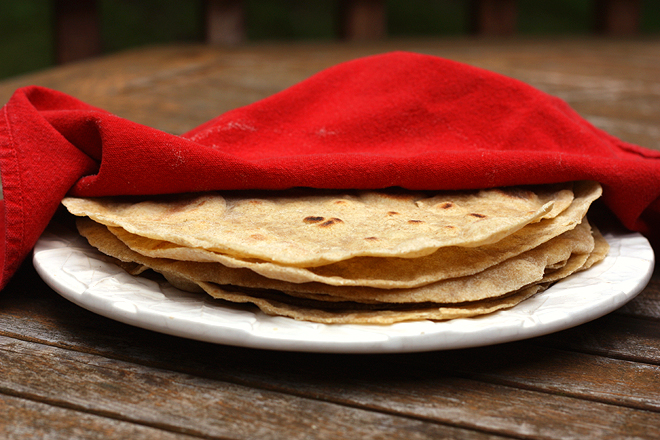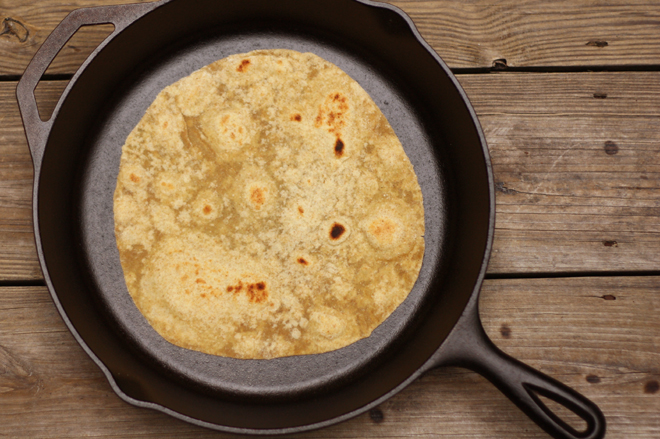 I originally posted this recipe on the very first day of the blog, January 23, 2009. I’m reprising today because I’ve changed the recipe a bit over the years (swapping in some whole wheat pastry flour for a softer tortilla, kneading a bit more and cooking a bit less) and to replace the truly awful original picture (taken with tungsten light, daylight and on-camera flash; oy!).
I originally posted this recipe on the very first day of the blog, January 23, 2009. I’m reprising today because I’ve changed the recipe a bit over the years (swapping in some whole wheat pastry flour for a softer tortilla, kneading a bit more and cooking a bit less) and to replace the truly awful original picture (taken with tungsten light, daylight and on-camera flash; oy!).
Also, I want to ask a question: I love this recipe, it is simple, relatively quick and fairly effortless. You don’t have to knead much, nor wait for a yeast-driven rise and you don’t have to fire up the oven to high heat, making this a perfect summer bread. But, while my tortillas stay soft when warm, they inevitably cool and parts become stiff, like a cracker, making it difficult to fold for a burrito or wrap. This seems to happen no matter how thick or thin I roll the dough or how little I manage to cook them in the skillet. Anyone have any tips for me on keeping the tortillas soft?
Tai is a big fan of the wrap sandwich, especially while working (one-handed lunches are ideal for rock climbing guides), but my wraps always seem to crack and fall apart, so we tend to buy them from the store. I apologize that I can’t remember the source of the original recipe, but if anyone has any tips for a persistently soft flour tortilla, I’d love to hear them. One less thing to buy from the grocery store is always a reason to celebrate.
—————————————————————————
INGREDIENTS
- 9 oz (2 cups) whole wheat bread flour
- 9 oz (about 2 cups) whole wheat pastry flour, plus extra for adjustments
- 1 tsp sea salt
- 1/2 cup olive oil
- about 1 cup hot water
METHODS
- Mix ingredients. In a large bowl, mix flours and salt. Add oil, toss with a fork, then rub between your fingers for a minute or two to evenly disperse; try to get all of the flour in touch with some oil. Gradually add hot water, mixing in with a wooden spoon. Knead in the bowl, with wet hands if necessary, as you add the last of the water. The dough should feel soft and only slightly sticky; if it is very sticky and/or does not hold it’s shape on kneading, add more flour. If it is too crumbly with visible flour, add more water, 1 tbsp at a time.
- Knead. Turn dough out onto a floured surface. Knead for a few minutes, adding minimal flour to prevent sticking, until dough is soft, pliable and uniform.
- Shape & rest. Cut dough into 12 equal pieces and form each into a ball the size of a lime. For each piece, roll under your palm, on a slightly wet surface, in a circular motion, pushing into your work surface while rotating the dough. This will form a nice, tight ball. Place on a clean, floured kitchen towel and cover lightly to rest for at least 15 minutes and up to 2 hours (for a longer rest, wrap tightly in plastic wrap to prevent drying of the dough).
- Form tortilla. Flatten a dough ball on a floured work surface and roll the dough out, roughly in a circle, until it is very thin, approximately 1/16 inch.
- Cook. Heat a large, dry skillet over medium-high flame. Add a rolled-out tortilla; when bubbles form (about 30-60 seconds) flip to the other side for about another 30 seconds. You can cook them for as long as you like, but at some point they will become stiff, more like a cracker than a soft flour tortilla. Experiment with the first few until you get the hang of it. Keep warm on a plate in a low oven, covered with a damp towel. Repeat with remaining tortillas.
Yields about a dozen, dinner-plate-sized tortillas.
- Add chili powder, dried or fresh herbs or other spices to the flour prior to adding the oil.
- Add fresh herbs, pesto, flavored oil, lime juice or other wet additions into the dough during kneading.
- Substitute up to 2 cups spelt, triticale, rye or other flours for a different flavor. These tortillas do not rely on gluten for shape or texture, so a GF flour substitute should be feasible (although you may need some sort of binder. If anyone tries it, please let us know how it goes.)
STORE
In the fridge for about a week. Freeze well for 6 months or longer.
SEASON
Year round.


Pingback: {weekend reading} NATIONAL edition « FROM SCRATCH club
Pingback: Aztec Soup | The Accidental Southerner
I usually warm tortillas and leave them under a warm wet paper towel to keep them soft during the meal.
The other thing, which I vaguely remember learning about in high school spanish class, is that the way they make them soft is to use lots and lots of lard. I would think bacon drippings might work too. But that definitely makes them unhealthy. And I have not tested this vague remembrance, so I take no credit if you try it and it is a disaster. 🙂
Mmmmm, bacon. You may be right, Melissa: lard is pretty much a staple of Mexican cooking and maybe the solid-at-room-temp thing is necessary for keeping them soft?
I can keep them soft throughout a meal, but I’m tyring to get them to stay soft at fridge temps, like the storebought ones. We ran out of Tai’s favorite habanero-lime wraps, so I can’t even check the ingredients list, but I’m fairly sure it’ll be a mile long.
I also vote more fat. A quick Google search revealed some recipes with milk… I’m not sure if that would make a difference though.
Since adding cornstarch to a fried chicken dredge made the crust limp after it cooled, maybe that would help with the tortillas. I have no idea of the chemistry involved in that, and maybe something else caused it (only did it that one time). And anyway, lard needs love too.
Looks great :)) Ive just started making my own , and am ready now to start experimenting . Im thinking the next ones will be 50% whole wheat , 50% corn masa… see how that turns out :))
I would also say add more fat, like bacon drippings, but why I’m really commenting is to observe that Rich’s monster is suspiciously similar to mine.
Good thought Anduin :)) Will try that too, Ive always thought it was too dry .
LOL and yes we could be from the same cauldron ? hahaha
I understand why everyone is suggesting more fat as that is likely the issue here but I would also like to thank you for posting a vegetarian tortilla recipe – they are hard to find! Maybe swapping some butter instead of olive oil would help with the softness?
I found a recipe that used shortening. I have tried it with the white tortillas but not the wheat yet. I will tell you how.it goes 🙂
Please do!
Well the shortening was the key to perfect tortillas! They came out poofy and pliable just like a tortilla should be! They need to cook a little bit longer but that is the only difference. Hope this helps ya out! 🙂
only thing is, shortening is not good for you…I may try coconut oil instead of olive oil
Avocado is supposed to be a 1:1 substitute for butter. They call avocados a “butter pear”. I wonder if either subbing avocado for the butter, and/or adding avocado to the original recipe would help to keep them soft. I haven’t tried it myself yet. I like the idea of using fresh or cold pressed unrefined coconut oil.